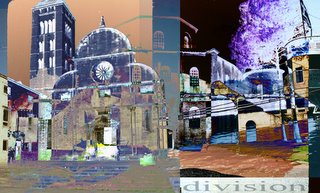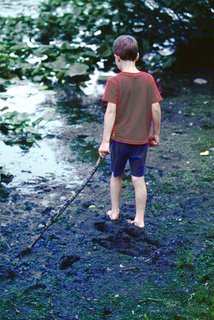I admit that I am most likely a better PhotoShop user than I am a photographer. I understand the concepts of a camera, exposure, and lighting; however, sometimes different films, film speeds, and lighting situations can very the outcome of the intended photograph. If you use PhotoShop correctly and are able to add, subtract, or manipulate pixels to a more positive outcome than the actual photograph. I feel that sometimes film or even digital pixels do not do a photograph justice due to lighting or the way your camera may have been set. With PhotoShop, you are able to strengthen your colors, adjust the white and black balances that your camera may not control.
I like to use PhotoShop as a post photographic tool. This means that once I get my prints or negatives, I can go through and give a final feeling that my original may lack. I have been asked if I think this is an ethical problem. I believe that a feeling can be manipulated through a camera so it should be ok to change the feeling of the scanned image. The only aspects I change in PhotoShop are white/black levels, color saturation/color correction, dust/scratch scanned dust from the originals, and every so often use the sharpen tool. Because I only touch the items that can be corrected in a photo lab, I feel that personal ethics I have never get tampered with.
Some of these ethical issues that should not be tampered with are adding content to an image, purposely selecting the background and distorting the blur amount (this can easily be done in the camera,) anything that dramatically changes the environment (such as taking out or adding trees to a picture,) or even something as simple as using a filter on a photograph. Once you have done something to change the original concept of the photograph, I now classify this as a computer graphic. Don’t get me wrong, that’s some of what PhotoShop is all about and even I have created plenty of computer graphics. These ethics I am talking about is a measure that many photographers use to keep their photography close to the way they shot it and to keep themselves as honest to their viewers as possible.
PhotoShop is used in a variety of ways: photography, graphic design, advertising, video production, animation, and many other fields that has visual needs. Once we start combining the use of PhotoShop for two or more of these industries we start to find a convergence of media that throws everything in a grey area. Digital photography and photography are considered a medium within the fields that are visual heavy and allow much convergence between manipulation and organization. I personally like to keep photography as its own entity especially when I complete a print to be showcased.
To me, the grey area can be described as computer design because whatever is in that region can be used for anything and everything. At that point, the purpose of the image is stripped away to be used for what ever the intended user wants.
Since the development of computer graphics I believe that photography has branched itself in a variety of directions. The farther we move away from the original concept and introduce new ways of changing a photograph, the less honest we can potentially become to our intended audience. The problem becomes dangerous when the viewer or the audience is not aware of the intended manipulation. Because PhotoShop is so capable of this type of manipulation and the fact that the user is becoming more efficient at it but turns it into a common occurrence. As viewers, it makes it harder for us to determine what fact verses fiction is.
MORE WORK.....
The first four images you see are computer enhanced in PhotoShop. Changing the original concept of the image that was shot.
Some computer art/design




Back to my photographs.....

"The Train" - sk2005

"County Fair" Series print #3 - sk2005

"In town celebrations" - sk1997

Home Fireworks series, print #7 - sk 2005

"Taste of Minnesota Fireworks" Print Series #13 - sk2005
3 comments:
Terrific Photo site- got here thru' Nikhil.Net site- I shall visit often.
Truly talented people like you need more exposure.
Please keep up the good work! I'm from MN too by the way :)
GOD bless you bro'!
-mags
jsmags.com
my favorite passtime is hacking pc but i like photos.
http://jsmags.wordpress.com
Dominique5599
i like it but my favorite passtime is hacking...
Dominique5599
Post a Comment